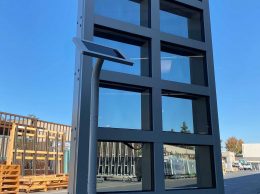Topaz Solar Farm stalls on financing
IN THIS ARTICLE
- Top Stories Topic
- Stephen Nellis Author
By Stephen Nellis Friday, September 30th, 2011
Construction has started on one of the massive solar energy farms on San Luis Obispo County’s Carrizo Plain, but the other is stalled until a new buyer is found after a $1.9 billion loan backstop from the U.S. Department of Energy fell through.
Dirt is moving on the California Valley Solar Ranch, a 250-megwattt installation being built by San Jose-based SunPower Corp. After an environmental review process that altered the solar farm’s footprint but left its power output intact, SunPower secured permits earlier this year.
In April, the Energy Department announced a conditional loan guarantee of $1.2 billion for the project, which it says will avoid 430,000 tons of carbon dioxide emissions and provide enough energy to power 60,000 homes. Officials from SunPower and the county say that the conditions of the guarantee have been met so far and grading work has started as planned.
But that is not the case for the Topaz Solar Farm, the much larger 550-megawatt project proposed by First Solar. Company spokesman Alan Bernheimer said First Solar was ready to begin construction by Sept. 30 as was outlined in its conditional loan guarantee for $1.9 billion from the Energy Department. Those plans halted when federal officials announced that the project was no longer eligible for the loan backing. Bernheimer said the company is close to finding a financier for the project.
“We are in advanced discussions with potential buyers who would not need a loan guarantee from the Department of Energy as part of their financing structure,” he said. The pullback of the loan guarantee was interpreted in the financial press as political backlash from the Solyndra scandal. That solar firm borrowed $527 million from the federal government before collapsing into bankruptcy and is now under criminal investigation. But neither of the Carrizo projects would involve receiving checks from the government. The loan guarantees involved are more like those provided by the U.S. Small Business Administration. They are essentially an insurance policy provided to a commercial bank — Royal Bank of Scotland, in First Solar’s case — to induce them to lend on a project that would not otherwise meet the bank’s risk guidelines.
“We tend to talk about it as a bridge for us when commercial debt markets are not as familiar with this kind of project,” Bernheimer said. “When they see that this project can provide an energy revenue stream for 25 years, they’ll come to understand it’s actually a very low-risk kind of project.”
Bernheimer said First Solar has no timeline for beginning construction but that financing is the main factor holding back a groundbreaking. A lawsuit was filed over the project — environmental regulators recommended reducing its output to 400 megawatts because of wildlife concerns, but county planners opted for the full output — but no injunction has been issued to stop work, Bernheimer said.
He said First Solar, which is a panel maker rather than an energy firm, has planned to sell the project from the beginning and that the latest roadblock only represents an acceleration of that prospect.
“Once we have financing arranged, we can ramp up construction pretty rapidly,” he said. “The important thing is the project is moving forward.”
On the California Valley project, which was farther along the regulatory pipeline, a company spokeswoman said the firm’s loan guarantee remains in place. County planner John MacKenzie said grading work has begun on the first phase of the project, which includes building roads to service it and installing some of the panels.
The company will still have to secure permits for outbuildings, a power substation and a reverse-osmosis water treatment facility, he said.










